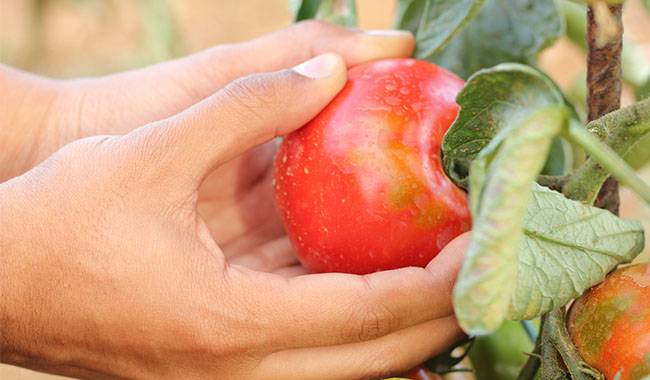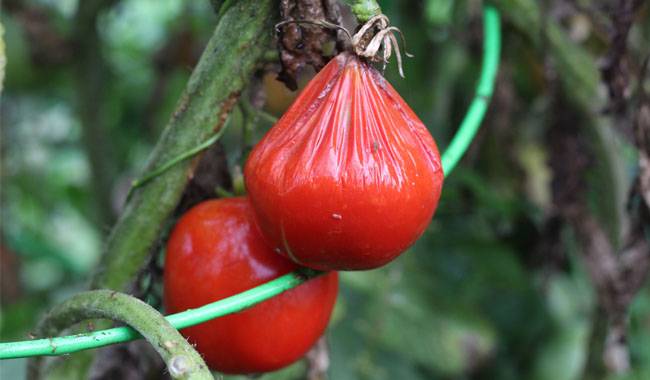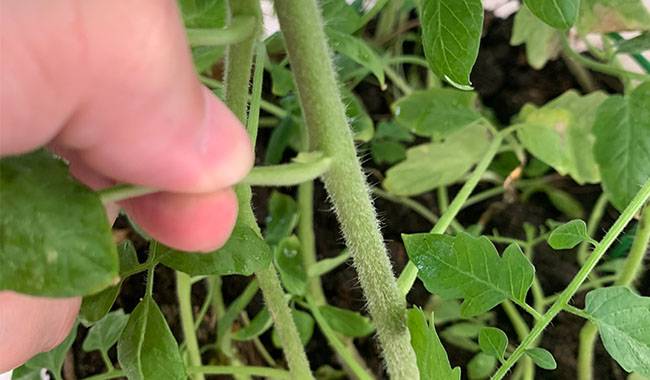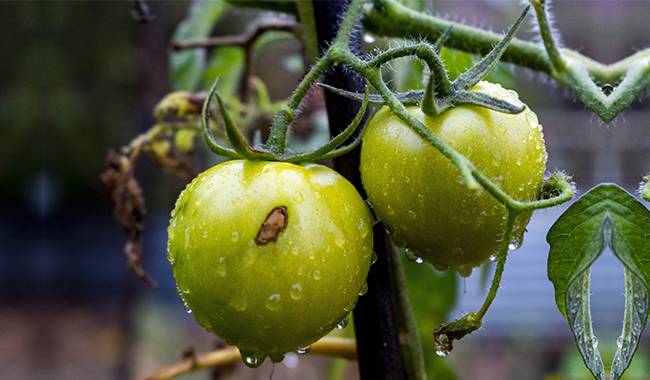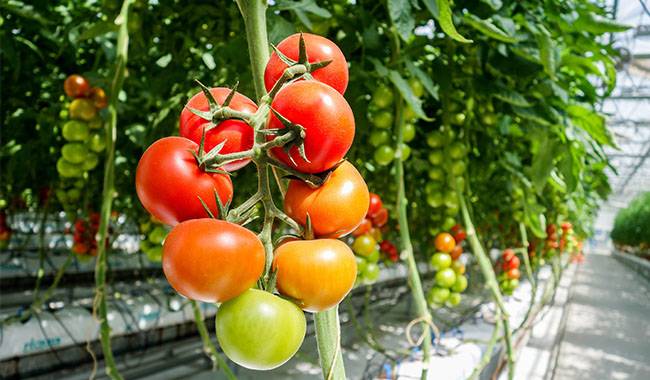
Assessing the external conditions of tomato seedlings, and ripening plants, most of us can‘t tell what they are lacking. Understanding the nutrient deficiency in tomatoes is useful not only for professionals but also for beginners in gardening.
Let’s consider the main signs of nutritional deficiencies and excesses in tomatoes. This will allow us not only to get a higher crop but also to avoid unnecessary worries, as well as the wrong use of chemicals, which tend to reach out at the sight of curled leaves and various spots.
The main nutrients of tomatoes are nitrogen, phosphorus, and potassium. Then comes calcium, sulfur, and magnesium. Finally: iron, boron, zinc, copper, manganese, molybdenum, and chlorine.
Consider in detail the symptoms of deficiencies and excesses of each element:
Deficiency or excess of nitrogen (N)
Nitrogen is one of the elements most needed by tomatoes. It is responsible for the growth, development, and yield of the plant. Deficiencies or excesses can negatively affect this crop.
Tomatoes have the greatest need for nitrogen nutrition in the early stages of development. It decreases somewhat during the flowering period and increases again after the formation of the first brushes. In the second half of the growing season, the need for phosphorus and potassium comes first, but again there is a moderate background of nitrogen.
Signs of nitrogen deficiency.
It first makes the lower leaves of tomatoes pale and curled. The back veins then turn light blue and reddish. The same color appears on the stems and petioles. Delays in plant development become apparent. New leaves grow small, dull, and pale green. Premature flowering occurs. Fruit production is small and, as a result, the harvest is of poor quality (fruits may be woody).
Signs of excess nitrogen.
Overgrowth. Tomatoes with large, juicy, richly colored leaves. The shoots are very strong. The young leaves are brittle and curled in a circular pattern. Flowering and later fruit ripening are delayed. The crop is sparsely productive.
Flowers and ovaries fall off if there are more than one-fifth of fruiting spikes (in case of N deficiency and K deficiency). On the background of phosphorus deficiency, the fruits show black streaks.
In addition, excess N causes impaired iron uptake by the plant and increases susceptibility to tomato diseases.
How can I compensate for nitrogen deficiency and reduce its excess?
If tomatoes show signs of nitrogen deficiency, they need to be fertilized with fertilizers containing nitrogen. Ammonium, calcium, sodium, potassium nitrate, urea, manure, and slurry are all acceptable. The characteristic of applying this type of fertilizer is that it needs to be embedded in the soil as early as possible, as nitrogen tends to evaporate out.
If there are signs of excess N, you need to increase light (in a greenhouse) and apply potassium fertilizers, as well as flush the soil with plenty of water.
Deficiency or excess of phosphorus (P)
Phosphorus plays a special role in the formation of the tomato root system and lays the foundation for the quantity and quality of the crop. Due to its deficiency, plants become more sensitive to diseases and low temperatures.
Signs of phosphorus deficiency.
The plant develops slowly, with prolonged starvation – growth stops. Stems and leaves are purple or purplish on the back. Leaflets curl upward, with prolonged starvation – downward. Young leaves are inclined at a small angle with respect to the main stem. Flowering is very sparse. Tomatoes are formed small and do not have a pronounced flavor.
Signs of excess phosphorus.
Plants have unnaturally short internodes. Young leaves are very thin with fading between the veins. Leaf tips and margins are burned off. Lower leaves are covered with spots and curled. The yield is very low.
How can I compensate for the deficiency of phosphorus in tomato nutrition?
Fertilizers containing phosphorus are needed. Suitable: potassium monophosphate, calcium superphosphate, phosphate flour, strongly diluted ash infusion of dry ash. This fertilizer is especially important before flowering.
However, phosphorus fertilizers have a peculiarity: they are not absorbed by plants until the soil temperature rises to 59°F (15°C) or higher. Therefore, for seedlings, raising the temperature to 73°F (23°C) may be sufficient to eliminate phosphorus starvation if optimum light and proper soil mixture preparation are available.
Deficiency or excess of Potassium (K)
Potassium is the element responsible for the immunity and production potential of tomatoes, the taste quality of their fruits, their management, and the accumulation of vitamin C in them.
Tomatoes love potassium! Therefore, when choosing a multi-nutrient fertilizer, you should look for a blend rich in potassium.
Potassium deficiency impairs the nitrogen metabolism of tomatoes. It leads to susceptibility to diseases and increased sensitivity to temperature changes and lack of moisture. However, signs of potassium deficiency are uncommon, mainly when potassium-loving crops are grown in the same place for a long time, with prolonged rainy seasons or, conversely, with prolonged water deficiency.
Signs of potassium deficiency.
Young tomato leaves grow small and dark, curl downward, become wrinkled, and their edges wither. Along the edges and tips of older leaves, there are signs of burning with a rusty color (burnt edges).
Intermittent chlorosis (spreading from the margins to the middle of the leaf) is observed around the necrotic spots of the leaf plate tissue. Discoloration of the smallest leaf veins. Gradual drying and crumbling of the leaf layers. Plants appear spotted and may be covered with rust if the infestation is severe.
The growth of tomatoes is slowed down. Active stem formation. Stems are very thin, brittle, and weak. Few buds appear. Fruit ripen unevenly and form black spots.
On ripe tomato fruit, a dense yellow spot (called “yellow shoulder”) forms on the stalk unless it is a varietal characteristic. In addition, in the case of potassium deficiency, stiff veins may form inside the fruit against a background of excess nitrogen and calcium deficiency.
Signs of excess potassium.
Plant growth is stunted and long internodes are formed. New leaves become smaller and thinner, with shrinkage between the veins. The top and edges of tomato leaf plates turn brown and eventually die. Lower leaves are covered with brown spots (Mosaic virus), wrinkled, wilted, curled, and fall off.
Excessive potassium causes difficulties in the assimilation of other elements, especially calcium and magnesium, in tomatoes.
How can I compensate for the lack of potassium in tomato nutrition?
Feeds containing potassium are needed. Suitable: potassium sulfate, potassium magnesium oxide, climax, potassium monophosphate, ash.
Deficiency or excess of Calcium (Ca)
Calcium is involved in the growth and development process of tomatoes. In its absence, root formation and root hair formation are slowed down.
Signs of calcium deficiency.
The growth of tomatoes is slowed down, and in severe deficiency, the tops may become shallow and die. Severely malnourished young leaves have pale spots and imitation creamy white tips that may have irregular shapes. Older leaves are large and dark green. Bud and ovary abscission can be observed. In case of severe deficiency, root tip rot may appear on the fruit.
Signs of excess calcium.
Tomato leaves have different configurations of light spots. The veins are green.
How to compensate for the deficiency of calcium in tomato nutrition?
Excess nitrogen, potassium, and manganese often lead to calcium deficiency. So you should apply them without breaking the rules. To compensate for calcium deficiency, foliar spraying of calcium nitrate is the best option. Calcium chloride, “Calbit C (a nutritional supplement based on a combination of calcium and LSA)”, and eggshell infusion are also suitable.
Sulfur (S) deficiency
Sulfur plays an important role in the respiratory process of tomato plants. If it is deficient, the plant will wilt. However, it can also be a sign that the soil is constantly being over-watered.
Signs of sulfur deficiency.
The external symptoms of sulfur deficiency are very similar to those of nitrogen deficiency. However, if in the case of nitrogen deficiency, the leaves of tomatoes begin to turn yellow from the lower part of the bush and sulfur – from the upper part. Over time, the faded leaves at the bottom, near the petiole, take on a pinkish hue. Their veins also become blue with a reddish tinge. The stems grow very hard, thin, stiff, and brittle.
How can I make up for the lack of sulfur in tomato nutrition?
To make up for the lack of sulfur, you can treat the plants with magnesium sulfate outside of the foliar spraying process.
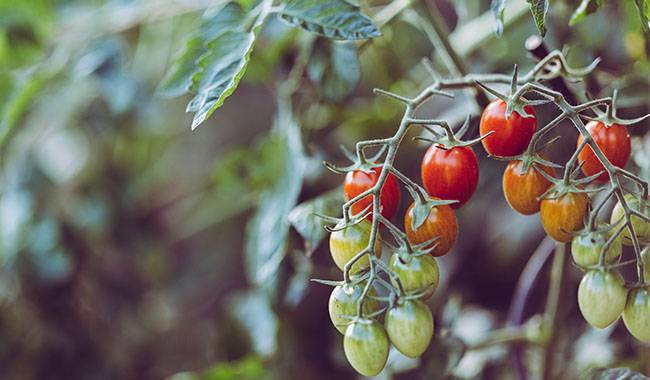
Magnesium (Mg) deficiency
If a tomato crop develops a magnesium deficiency, it will show symptoms when it has too much fruit.
Signs of magnesium deficiency.
Tomato leaves, starting from the lower layers, bend upwards in a domed fashion and turn yellow, their edges wrinkle and contract. Veins and their surrounding areas do not change color.
How to compensate for the deficiency of magnesium in tomato nutrition?
To compensate for the lack of magnesium, tomatoes can be foliar fed with a solution of British salt and magnesium nitrate.
Deficiency or excess of Iron (Fe)
Iron deficiency is most commonly seen in tomato seedlings on calcareous soils.
Signs of iron deficiency.
Yellowing of the plant in the direction from the stem to the tip of the young leaves. Veins become lighter in the same direction and remain green only at the edges of the leaf plates. Tomatoes can also appear stunted and form small flowers.
Signs of excess iron.
At first glance, unreasonable green leaves die. Stops growth. Formation of a small number of flowers. Dying down from above. Shrinkage.
How to compensate for the lack of iron in tomato nutrition?
Treating plants on the green with a weak solution of ferrous sulfate or ferric alum, repeated 2-3 times, can compensate for iron deficiency fairly quickly.
Boron (B) Deficiency
The main danger of boron deficiency in tomatoes is the inability to set fruit. In addition, resistance to diseases can deteriorate.
Signs of boron deficiency.
In mild boron deficiency, tomatoes bloom but do not set fruit. The tips become bright and curl downward. With a stronger one, which is not common, the leading growth point dies. Young leaves curl from the tip to the petiole. The large leaf veins become dark (brown, black) and the leaves become brittle. Stems are densely formed. Dark brown necrotic spots may appear on the fruit.
How to compensate for the deficiency of boron in tomato nutrition?
Compensate for boron deficiency by treating the leaves of tomatoes with a boric acid solution during flowering. Repeat the treatment several times.
Zinc (Zn) deficiency
Zinc plays a leading role in the growth of tomatoes and in the synthesis of vitamins. Deficiencies of this element occur in sandy, gravelly, and carbonate soils.
Signs of zinc deficiency.
Young tomato leaves form atypical small, narrow, slightly upright growth. They are often covered with small yellow dots or lightened. On the main leaves, gray-brown spots of various sizes, including veins, appear, starting at the lower levels. The margins of the leaves curl upward. The leaves gradually wither completely. The same spots appear on the petioles and stems.
How can zinc deficiency be remedied?
Zinc deficiency on tomatoes can be remedied by foliar spraying with zinc sulfate solution.
Copper (Cu) deficiency
Copper is involved in many physical processes in plants, including respiration and the development of stress resistance.
Signs of copper deficiency.
Tomato leaves are dull (especially at the top), bleached at the ends, and twisted into a tube. The newcomers grow small with a blue tinge. Shoots are weak. Flowers are dropping.
How can copper deficiency be remedied?
Copper deficiency can be remedied by spraying the leaves with copper sulfate solution.
Manganese (Mn) deficiency
Manganese deficiency in tomatoes is quite rare. Mostly on calcareous soils and when irrigated with very hard water.
Signs of Manganese deficiency.
Tomato leaves are spotted with the Mosaic virus. starts to lighten at the bottom of the upper layer. Variegated veins, darker than iron deficiency. Small flowers are falling off.
How can I compensate for the manganese deficiency?
It is recommended to treat the green part of tomatoes with a manganese sulfate solution to make up for the manganese deficiency.
Molybdenum (Mo) deficiency
Molybdenum deficiency in tomatoes is extremely rare.
Signs of molybdenum deficiency.
The young leaves of the tomatoes turn from green to mottled. Subsequently, the lightened tissue swells, and the edges of the leaf plates die and curl inward. The first two pairs of leaves also bleach and curl upward. The blood vessels do not change color.
How can I compensate for the molybdenum deficiency?
Tomatoes can be remedied by feeding them with an ammonium molybdate solution.
Chlorine (Cl) deficiency
Chlorine deficiency in tomatoes is rare. It can be observed, except in leached soils.
Signs of chlorine deficiency.
Young tomato leaves have a distinct intermittent shrivel, irregular shape, and wilting. Over time, there is a bronze tint on older leaves.
How can I compensate for the chlorine deficiency?
To compensate for the lack of chlorine in tomatoes, foliar treatment of the leaves with a solution of potassium chloride can be applied.
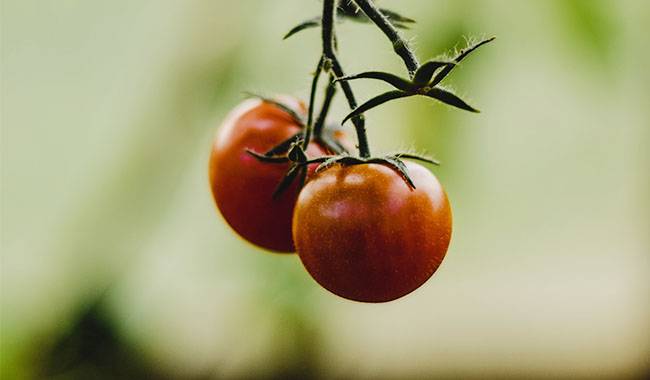
Other causes of tomato disease
These are the main signs of deficiency of the most important nutrients in tomatoes. However, when studying tomato beds, you should not forget that the sickly appearance of the plant can also develop under the influence of various other factors.
In the spring – it is a strong drop in nighttime temperatures. In the summer – it is a lack of moisture, disease, pests. Closure of the groundwater table. Water accumulation in the root zone. Wind. Natural aging of the plant – in the second half of summer, the lower leaves of tomatoes begin to turn yellow.
But if all these causes are absent and external signs indicate a deficiency of one element or another, it is worth paying attention to supplementation.
However, you must apply fertilizer at the right time and not in excess. This is because over-fertilization is just as harmful to tomatoes as under-fertilization. For example, one of the signs of excess nutrients is the elongation of the sides and knees of the tomato brush (the part of the brush that holds the fruit in place).
As it happens, tomatoes are deficient in several nutrients at the same time. In this case, when the main deficient element is applied (determined by the main symptom), the plant responds to its supplementation and by the remaining signs, the next element deficiency can be determined.
Fertilization rules
To ensure that plants do not suffer from nutrient deficiencies or excesses, you need to apply mineral and organic fertilizers according to the right rules. First, in early spring or autumn under major tillage, and second, at certain stages of plant development.
Use a balanced substrate to grow tomato seedlings. Carry out the planned fertilization in a timely manner. Observe the recommended temperature and light regimes.
When faced with nutrient shortages between foliar and topdressing applications, the foliar application is the preferred solution because of the need to act quickly on the plants in such difficult situations.
Topdressing of tomato plants should be done in the evening or early morning. In dry, windless weather. Do not apply in hot weather. When spraying, treat both the upper and lower parts of the leaves. The underside of the leaf has more stomata through which the water-soluble fertilizer is absorbed.




